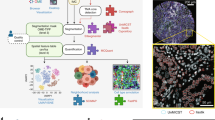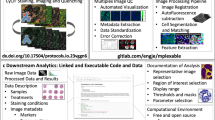Abstract
Histological staining and analysis of tissue sections is integral to diagnosis and treatment of many diseases, including cancer. Multiplex imaging technologies (e.g., cyclic immunostaining) have dramatically increased capabilities for assessing prognostic biomarkers in situ, enabling new insights into complex diseases. However, high-resolution, multiplex image data can be terabytes (TB) in size, and traditional pipelines for image analysis are not suited for these rich datasets. While much software development effort goes towards improving image processing tools such as stitching, registration, and segmentation; integration of these tools into a pipeline is often manual, which is highly laborious, error-prone and lacks reproducibility and scalability. Therefore, we developed a Python3 library, cmIF, a free and open-source tool to handle our high-throughput multiplex image processing pipeline. cmIF enables analysis of full-slide pathology tissue sections and tissue microarrays (TMAs), facilitating processing from raw image files through registration, segmentation, feature extraction, manual thresholding, and spatial pattern analysis. Our cmIF library includes functionality for image handling, quality control, metadata extraction, and subtraction of background images (i.e., autofluorescence subtraction). Additionally, it includes a Jupyter notebook for efficient generation and visualization of manual thresholds. Compared to a manual pipeline, use of cmIF reduces errors and improves processing time of datasets from weeks to hours, while documenting processing steps for reproducibility. All code is available on https://gitlab.com/engje/cmif. While our library is specific to our pipeline elements, it is a blueprint for types of functions needed for high throughput analysis. In the future, we will continue developing this open-source tool, and with input from the wider community, adapt it to a range of multiplex image pipelines.
J.W. Gray, K. Chin, Y.H. Chang—Contributed equally.
Access this chapter
Tax calculation will be finalised at checkout
Purchases are for personal use only
Similar content being viewed by others
References
Hanahan, D.: A: hallmarks of cancer: the next generation. Cell 144(5), 646–674 (2011)
Eng, J., Thibault, G., Luoh, S.-W., Gray, J.W., Chang, Y.H., Chin, K.: Cyclic multiplexed-immunofluorescence (cmIF), a highly multiplexed method for single-cell analysis. In: Thurin, M., Cesano, A., Marincola, Francesco M. (eds.) Biomarkers for Immunotherapy of Cancer. MMB, vol. 2055, pp. 521–562. Springer, New York (2020). https://doi.org/10.1007/978-1-4939-9773-2_24
Lin, J.-R.: A simple open-source method for highly multiplexed imaging of single cells in tissues and tumors. ELife, 7 (2018)
Tsujikawa, T.: Quantitative multiplex immunohistochemistry reveals myeloid-inflamed tumor-immune complexity associated with poor prognosis. Cell Rep. 19(1), 203–217 (2017)
Goltsev, Y.: Deep profiling of mouse splenic architecture with resource deep profiling of mouse splenic architecture with CODEX multiplexed imaging. Cell 174(4), 968–981 (2018)
McKinley, E.T.: Optimized multiplex immunofluorescence single-cell analysis reveals tuft cell heterogeneity. JCI Insight 2(11), 93487 (2017)
Gut, G.: Multiplexed protein maps link subcellular organization to cellular states. Science 361, 7042 (2018)
Pang, Z.: Dark pixel intensity determination and its applications in normalizing different exposure time and autofluorescence removal. J. Microsc. 246, 1–10 (2012)
Czech, E.: Cytokit: a single-cell analysis toolkit for high dimensional fluorescent microscopy imaging. BMC Bioinformatics 20(448), 1–13 (2018)
Schapiro, D.: histoCAT : analysis of cell phenotypes and interactions in multiplex image cytometry data. Nat. Methods 14(9), 873 (2017)
Keren, L.: A Structure tumor-immune microenvironment in triple negative breast cancer revealed by multiplexed ion beam imaging. Cell 174(6), 1373–1387.e19 (2018)
Funding
NIH/NCI U54 CA209988, NIH/NCI U2C CA233280, Prospect Creek Foundation, Susan G. Komen Foundation, OHSU Foundation, and Oregon Clinical & Translational Research Institute.
Author information
Authors and Affiliations
Corresponding author
Editor information
Editors and Affiliations
Rights and permissions
Copyright information
© 2019 Springer Nature Switzerland AG
About this paper
Cite this paper
Eng, J. et al. (2019). cmIF: A Python Library for Scalable Multiplex Imaging Pipelines. In: Bebis, G., Benos, T., Chen, K., Jahn, K., Lima, E. (eds) Mathematical and Computational Oncology. ISMCO 2019. Lecture Notes in Computer Science(), vol 11826. Springer, Cham. https://doi.org/10.1007/978-3-030-35210-3_3
Download citation
DOI: https://doi.org/10.1007/978-3-030-35210-3_3
Published:
Publisher Name: Springer, Cham
Print ISBN: 978-3-030-35209-7
Online ISBN: 978-3-030-35210-3
eBook Packages: Computer ScienceComputer Science (R0)




